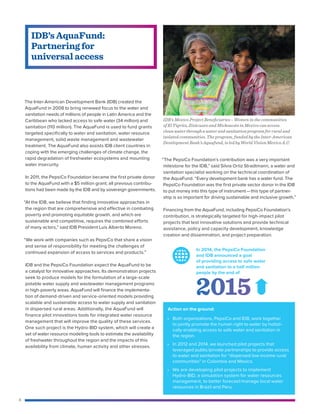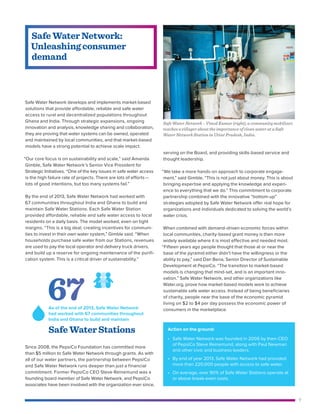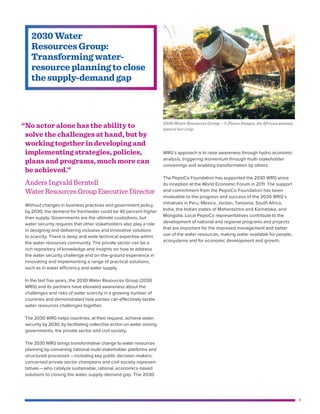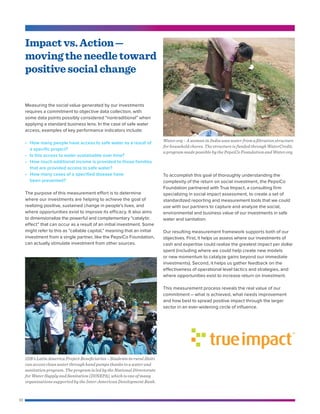PepsiCo is actively addressing the global water crisis by promoting holistic water stewardship and partnerships to provide access to safe water for underserved communities globally. The company has set ambitious goals to improve water use efficiency and expand its initiatives, with a commitment to providing safe water access to millions of people in various countries. Through collaborations with various organizations, PepsiCo aims to implement sustainable solutions that ensure long-term access to safe water and sanitation while recognizing water as a fundamental human right.













![12
To capture the overall impact of PepsiCo Foundation’s various
safe water investments across the globe, we first developed
an integrated theory of change model to harmonize social-
outcome objectives across our implementation partners.
Then, we developed standardized performance indicators —
including social value generated, cost per outcome and select
process performance metrics — to ensure accountability and
promote continuous improvement for our investment decisions
and among our implementation partners.
We envision expanding this measurement structure, inviting
any safe water access funder or implementer to contribute
to and learn from the successes and failures of the broader
network, to help us all achieve our goals.
Measurement Framework
Theory of Change:
Safe Water Access Investment Portfolio (Composite Model)
Process.
How well are the standardized components within our invest-
ments performing (vs. the rest of our portfolio or the sector
overall)? Are there opportunities to improve (i.e., best practices
to leverage or weaknesses to address)? E.g.:
Investment and Managerial Metrics
Social Value.
How much are our investments improving the social problems
we care about? E.g.:
• X million people provided access to safe water
• $X additional income generated for X families
• Prevented X thousands of cases of [specified disease]
Cost per Outcome.
How efficiently are our investments creating the social value we’ve
targeted (i.e., are we maximizing our return on investment [ROI]
compared to other program designs or investment options)? E.g.:
• Option A: $40 = 1 person provided safe water access
• Option B: $25 = 1 person provided safe water access
Standardized
Components
($) Avg.
cost / unit
(#) People
served / unit
(%) Success
Rate
Hygiene Training $2,750 35 72%
HH Rainwater
Harvest
$325 4.3 99%
INPUTS
(resources invested)
INVESTMENT METRICS MANAGERIAL METRICS
OUTPUTS
(goods/services delivered)
Promote watershed
health and accessibility
Conservation
Distribution
Create new distribution systems
Upgrade existing
distribution systems
Purification and Sanitation
Build new sanitation
systems and practices
Promote hygienic behavior
OUTCOMES
(change in targeted social conditions)
Increase access to safe water
Health gains
Economic gains
Time gains (and ripple effects)
Loans
PepsiCo Foundation Funds
Co-investment Grant Funds
Catalyzed Projects](https://image.slidesharecdn.com/waterreport-150302074720-conversion-gate01/85/Water-Report-Pepsico-14-320.jpg)

